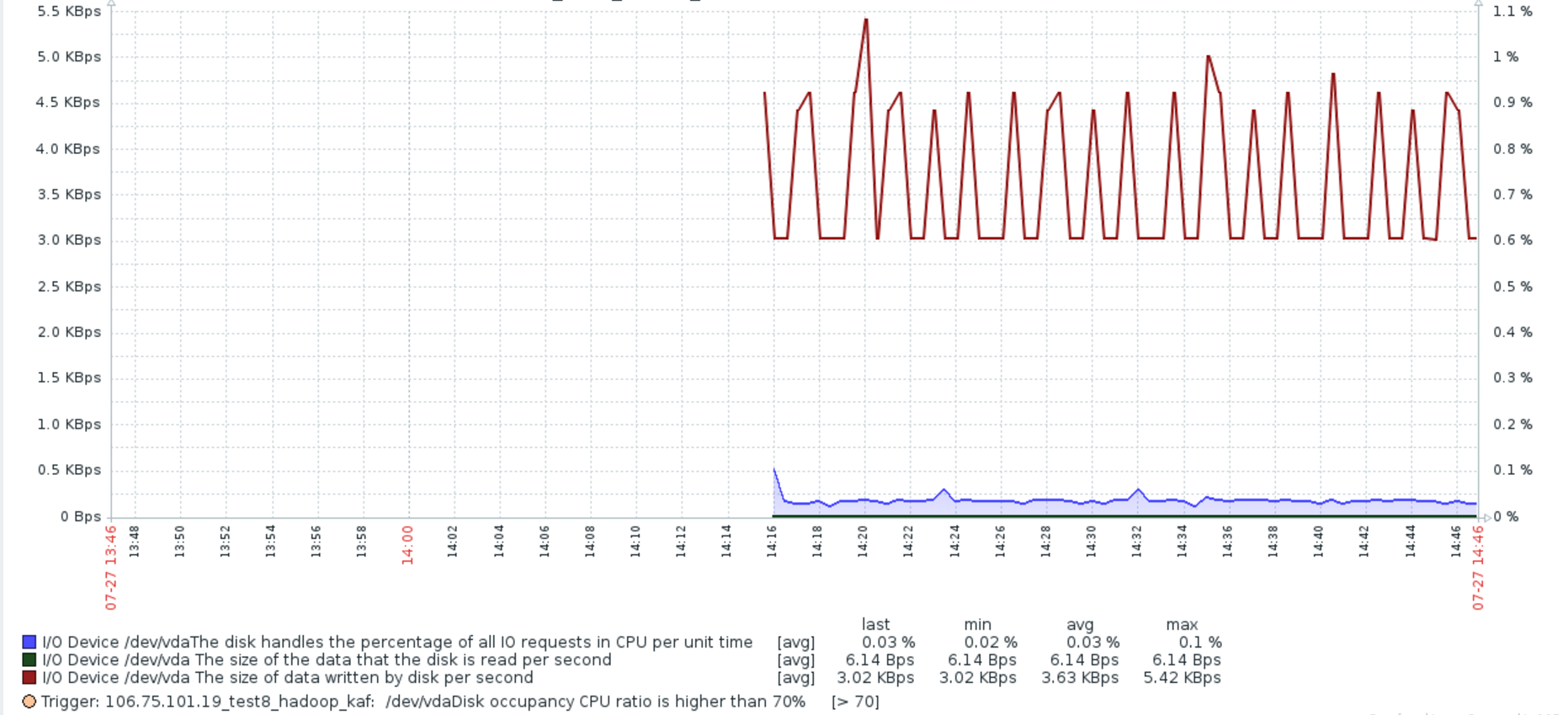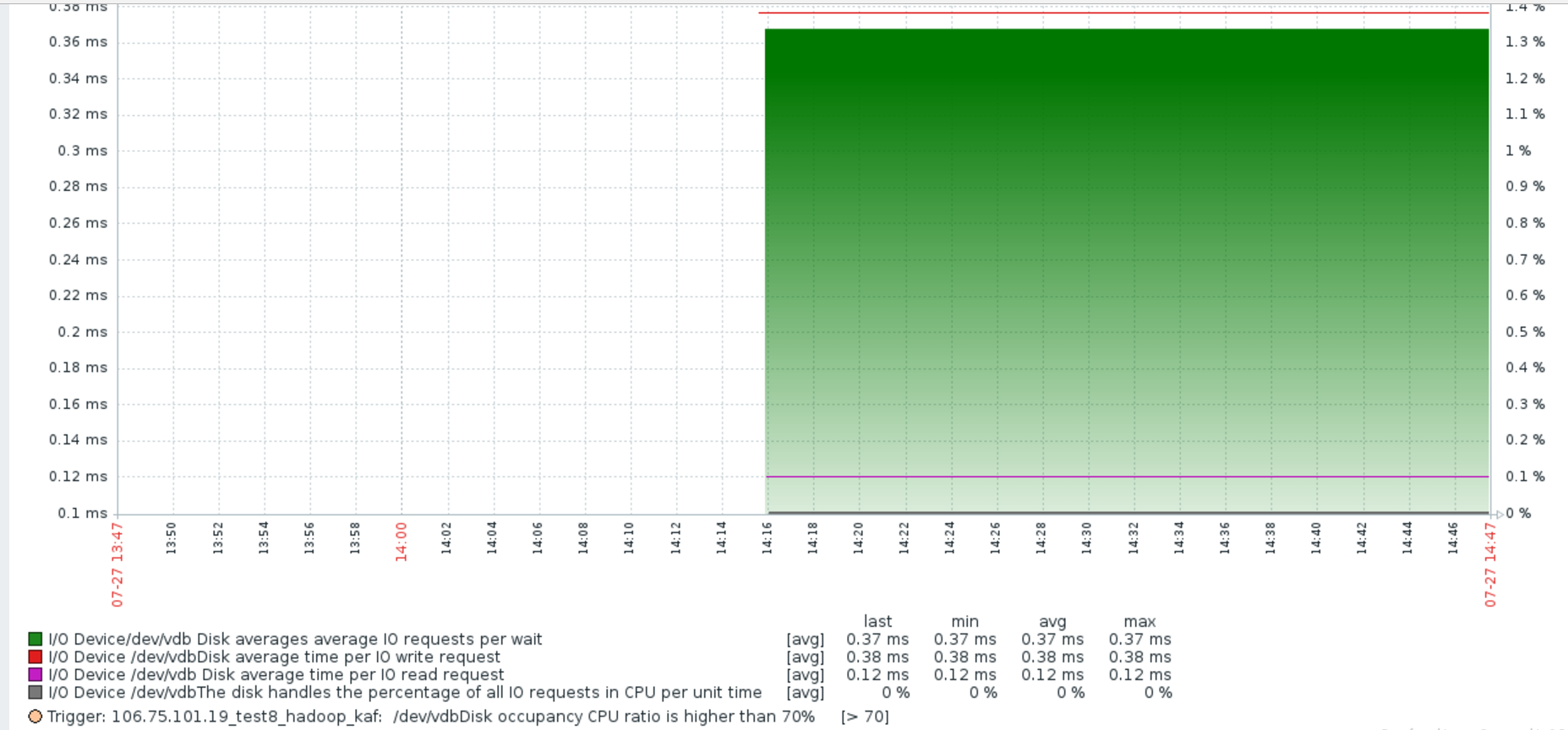zabbix3.0.4利用iostat工具监控centos主机磁盘IO
该监控基于iostat,然后iostat 命令用来监视系统输入/输出设备负载
1.安装IOSTAT工具
# yum install sysstat -y
测试iostat 查看所有硬盘io
# iostat
Linux 2.6.-431.11..el6.ucloud.x86_64 (test8_hadoop_kaf) // _x86_64_ ( CPU) avg-cpu: %user %nice %system %iowait %steal %idle
0.04 0.00 0.04 0.00 0.00 99.92 Device: tps Blk_read/s Blk_wrtn/s Blk_read Blk_wrtn
vda 0.10 0.23 0.92
vdb 0.00 0.00 0.15
2.部署脚本
# mkdir -p /usr/local/zabbix-agent/scripts/
# vim /usr/local/zabbix-agent/scripts/zabbix-iostat.sh
#!/bin/bash ZBX_DEV="$1"
ZBX_METRIC="$2"
IOSTAT_LOG=/tmp/iostat.log # Check iostat util
if ! which iostat >&>/dev/null; then
>& echo "Can't find 'iostat' binary in \$PATH"
>& echo "Make sure that you've installed 'sysstat' package"
exit
fi # Check args
[[ $# -lt ]] && { echo "Give some more arguments, please :)"; exit ; } # Discovering devices and spits out JSON
if [ "$ZBX_DEV" = 'discovery' ]; then
iostat -d | \
tail -n + |
awk 'BEGIN {
ORS="";
print "{\"data\":["}
/\d/ {printf "%s{\"%s\":\"%s\"}", separator, "{#DEVICENAME}", $, separator = ","}
END {print "]}" }'
exit
fi # Test iostat log
[[ ! -f "${IOSTAT_LOG}" ]] && echo "[m|ZBX_NOTSUPPORTED] [No such file ${IOSTAT_LOG}]" && exit # Parse iostat file
function parse_iostat() {
grep ${ZBX_DEV} ${IOSTAT_LOG} | \
tr ',' '.' | \
awk -v field="$1" '
{sum+=$field; n++;}
END {if (n > ) print sum/n;
else {print "[m|ZBX_NOTSUPPORTED] [Nodata.]" > "/dev/stderr"; exit };}'
} # Exec parse funcion with number of column
case ${ZBX_METRIC} in
rrqm/s ) parse_iostat '';;
wrqm/s ) parse_iostat '';;
r/r ) parse_iostat '';;
w/r ) parse_iostat '';;
rkb/s ) parse_iostat '';;
wkb/s ) parse_iostat '';;
avgrq-sz ) parse_iostat '';;
avgqu-sz ) parse_iostat '';;
await ) parse_iostat '';;
r_await ) parse_iostat '';;
w_await ) parse_iostat '';;
svctm ) parse_iostat '';;
util ) parse_iostat '';;
* ) echo "[m|ZBX_NOTSUPPORTED] [Unsupported item key.]" && exit ;;
esac
添加脚本执行权限
# chmod +x /usr/local/zabbix-agent/scripts/zabbix-iostat.sh
# 设置参数
# echo 'UserParameter=iostat[*],/usr/local/zabbix-agent/scripts/zabbix-iostat.sh "$1" "$2"' > /etc/zabbix/zabbix_agentd.d/iostat.conf
#重启zabbix_agentd
service zabbix-agent restart
# 测试自动发现
zabbix_agentd -t iostat[discovery]
3.加入crontab
# crontab -e * * * * * ( sleep && iostat -dxk > /tmp/iostat.tmp && mv /tmp/iostat.tmp /tmp/iostat.log )
* * * * * ( sleep && iostat -dxk > /tmp/iostat.tmp && mv /tmp/iostat.tmp /tmp/iostat.log )
# 重启计划任务
/etc/init.d/crond restart
测试监控项
# zabbix_agentd -t iostat[vda,rkb/s]
iostat[vda,rkb/s] [t|0.007]
图像展示


模板:
Template_Linux_DISK_IO_Discovery_English.xml
<?xml version="1.0" encoding="UTF-8"?>
<zabbix_export>
<version>3.0</version>
<date>2017-07-27T06:45:24Z</date>
<groups>
<group>
<name>Templates</name>
</group>
</groups>
<templates>
<template>
<template>Template_Linux_DISK_IO_Discovery_English</template>
<name>Template_Linux_DISK_IO_Discovery_English</name>
<description>Low-Level Discovery disk devices and I/O Performance monitoring</description>
<groups>
<group>
<name>Templates</name>
</group>
</groups>
<applications>
<application>
<name>DISK/IO</name>
</application>
</applications>
<items/>
<discovery_rules>
<discovery_rule>
<name>Disk devices discovery</name>
<type>0</type>
<snmp_community/>
<snmp_oid/>
<key>iostat[discovery]</key>
<delay>300</delay>
<status>0</status>
<allowed_hosts/>
<snmpv3_contextname/>
<snmpv3_securityname/>
<snmpv3_securitylevel>0</snmpv3_securitylevel>
<snmpv3_authprotocol>0</snmpv3_authprotocol>
<snmpv3_authpassphrase/>
<snmpv3_privprotocol>0</snmpv3_privprotocol>
<snmpv3_privpassphrase/>
<delay_flex/>
<params/>
<ipmi_sensor/>
<authtype>0</authtype>
<username/>
<password/>
<publickey/>
<privatekey/>
<port/>
<filter>
<evaltype>0</evaltype>
<formula/>
<conditions>
<condition>
<macro>{#DEVICENAME}</macro>
<value>^(sd|hd|vd|xvd)[a-z]$</value>
<operator>8</operator>
<formulaid>A</formulaid>
</condition>
</conditions>
</filter>
<lifetime>30</lifetime>
<description>Disk devices discovery and IO Performance monitoring</description>
<item_prototypes>
<item_prototype>
<name>I/O Device /dev/$1 The average size (sector) of the disk each IO operation</name>
<type>0</type>
<snmp_community/>
<multiplier>0</multiplier>
<snmp_oid/>
<key>iostat[{#DEVICENAME},avgrq-sz]</key>
<delay>30</delay>
<history>7</history>
<trends>365</trends>
<status>0</status>
<value_type>0</value_type>
<allowed_hosts/>
<units>sectors</units>
<delta>0</delta>
<snmpv3_contextname/>
<snmpv3_securityname/>
<snmpv3_securitylevel>0</snmpv3_securitylevel>
<snmpv3_authprotocol>0</snmpv3_authprotocol>
<snmpv3_authpassphrase/>
<snmpv3_privprotocol>0</snmpv3_privprotocol>
<snmpv3_privpassphrase/>
<formula>1</formula>
<delay_flex/>
<params/>
<ipmi_sensor/>
<data_type>0</data_type>
<authtype>0</authtype>
<username/>
<password/>
<publickey/>
<privatekey/>
<port/>
<description>The average size (in sectors) of the requests that were issued to the device.
向设备发出的请求的平均大小(扇区)。</description>
<inventory_link>0</inventory_link>
<applications>
<application>
<name>DISK/IO</name>
</application>
</applications>
<valuemap/>
<logtimefmt/>
<application_prototypes/>
</item_prototype>
<item_prototype>
<name>I/O Device/dev/$1 Disk averages average IO requests per wait</name>
<type>0</type>
<snmp_community/>
<multiplier>0</multiplier>
<snmp_oid/>
<key>iostat[{#DEVICENAME},await]</key>
<delay>30</delay>
<history>7</history>
<trends>365</trends>
<status>0</status>
<value_type>0</value_type>
<allowed_hosts/>
<units>ms</units>
<delta>0</delta>
<snmpv3_contextname/>
<snmpv3_securityname/>
<snmpv3_securitylevel>0</snmpv3_securitylevel>
<snmpv3_authprotocol>0</snmpv3_authprotocol>
<snmpv3_authpassphrase/>
<snmpv3_privprotocol>0</snmpv3_privprotocol>
<snmpv3_privpassphrase/>
<formula>1</formula>
<delay_flex/>
<params/>
<ipmi_sensor/>
<data_type>0</data_type>
<authtype>0</authtype>
<username/>
<password/>
<publickey/>
<privatekey/>
<port/>
<description>await: 平均每次IO请求等待时间(包括等待时间和处理时间,毫秒为单位)</description>
<inventory_link>0</inventory_link>
<applications>
<application>
<name>DISK/IO</name>
</application>
</applications>
<valuemap/>
<logtimefmt/>
<application_prototypes/>
</item_prototype>
<item_prototype>
<name>I/O Device /dev/$1 The number of sectors that the disk successfully reads per second</name>
<type>0</type>
<snmp_community/>
<multiplier>0</multiplier>
<snmp_oid/>
<key>iostat[{#DEVICENAME},r/r]</key>
<delay>30</delay>
<history>7</history>
<trends>365</trends>
<status>0</status>
<value_type>0</value_type>
<allowed_hosts/>
<units>Rps</units>
<delta>0</delta>
<snmpv3_contextname/>
<snmpv3_securityname/>
<snmpv3_securitylevel>0</snmpv3_securitylevel>
<snmpv3_authprotocol>0</snmpv3_authprotocol>
<snmpv3_authpassphrase/>
<snmpv3_privprotocol>0</snmpv3_privprotocol>
<snmpv3_privpassphrase/>
<formula>1</formula>
<delay_flex/>
<params/>
<ipmi_sensor/>
<data_type>0</data_type>
<authtype>0</authtype>
<username/>
<password/>
<publickey/>
<privatekey/>
<port/>
<description>The number (after merges) of read requests completed per second for the device.</description>
<inventory_link>0</inventory_link>
<applications>
<application>
<name>DISK/IO</name>
</application>
</applications>
<valuemap/>
<logtimefmt/>
<application_prototypes/>
</item_prototype>
<item_prototype>
<name>I/O Device /dev/$1 The size of the data that the disk is read per second</name>
<type>0</type>
<snmp_community/>
<multiplier>1</multiplier>
<snmp_oid/>
<key>iostat[{#DEVICENAME},rkb/s]</key>
<delay>30</delay>
<history>7</history>
<trends>365</trends>
<status>0</status>
<value_type>0</value_type>
<allowed_hosts/>
<units>Bps</units>
<delta>0</delta>
<snmpv3_contextname/>
<snmpv3_securityname/>
<snmpv3_securitylevel>0</snmpv3_securitylevel>
<snmpv3_authprotocol>0</snmpv3_authprotocol>
<snmpv3_authpassphrase/>
<snmpv3_privprotocol>0</snmpv3_privprotocol>
<snmpv3_privpassphrase/>
<formula>1024</formula>
<delay_flex/>
<params/>
<ipmi_sensor/>
<data_type>0</data_type>
<authtype>0</authtype>
<username/>
<password/>
<publickey/>
<privatekey/>
<port/>
<description>The number of bytes read from the device per second
每秒从设备读取的字节数</description>
<inventory_link>0</inventory_link>
<applications>
<application>
<name>DISK/IO</name>
</application>
</applications>
<valuemap/>
<logtimefmt/>
<application_prototypes/>
</item_prototype>
<item_prototype>
<name>I/O Device /dev/$1 The number of read requests merged per second that were queued to the device</name>
<type>0</type>
<snmp_community/>
<multiplier>0</multiplier>
<snmp_oid/>
<key>iostat[{#DEVICENAME},rrqm/s]</key>
<delay>30</delay>
<history>7</history>
<trends>365</trends>
<status>0</status>
<value_type>0</value_type>
<allowed_hosts/>
<units>rrqm/s</units>
<delta>0</delta>
<snmpv3_contextname/>
<snmpv3_securityname/>
<snmpv3_securitylevel>0</snmpv3_securitylevel>
<snmpv3_authprotocol>0</snmpv3_authprotocol>
<snmpv3_authpassphrase/>
<snmpv3_privprotocol>0</snmpv3_privprotocol>
<snmpv3_privpassphrase/>
<formula>1</formula>
<delay_flex/>
<params/>
<ipmi_sensor/>
<data_type>0</data_type>
<authtype>0</authtype>
<username/>
<password/>
<publickey/>
<privatekey/>
<port/>
<description>The number of read requests merged per second that were queued to the device
每秒排队到设备上的合并请求数</description>
<inventory_link>0</inventory_link>
<applications>
<application>
<name>DISK/IO</name>
</application>
</applications>
<valuemap/>
<logtimefmt/>
<application_prototypes/>
</item_prototype>
<item_prototype>
<name>I/O Device /dev/$1 Disk average time per IO read request</name>
<type>0</type>
<snmp_community/>
<multiplier>0</multiplier>
<snmp_oid/>
<key>iostat[{#DEVICENAME},r_await]</key>
<delay>30</delay>
<history>7</history>
<trends>365</trends>
<status>0</status>
<value_type>0</value_type>
<allowed_hosts/>
<units>ms</units>
<delta>0</delta>
<snmpv3_contextname/>
<snmpv3_securityname/>
<snmpv3_securitylevel>0</snmpv3_securitylevel>
<snmpv3_authprotocol>0</snmpv3_authprotocol>
<snmpv3_authpassphrase/>
<snmpv3_privprotocol>0</snmpv3_privprotocol>
<snmpv3_privpassphrase/>
<formula>1</formula>
<delay_flex/>
<params/>
<ipmi_sensor/>
<data_type>0</data_type>
<authtype>0</authtype>
<username/>
<password/>
<publickey/>
<privatekey/>
<port/>
<description>The average time (in milliseconds) for read requests issued to the device to be served. This includes the time spent by the requests in queue and the time spent servicing them.
向设备发出的读取请求的平均时间(毫秒)。这包括队列中请求的时间和为它们服务的时间。</description>
<inventory_link>0</inventory_link>
<applications>
<application>
<name>DISK/IO</name>
</application>
</applications>
<valuemap/>
<logtimefmt/>
<application_prototypes/>
</item_prototype>
<item_prototype>
<name>I/O Device /dev/$1The disk handles the percentage of all IO requests in CPU per unit time</name>
<type>0</type>
<snmp_community/>
<multiplier>0</multiplier>
<snmp_oid/>
<key>iostat[{#DEVICENAME},util]</key>
<delay>30</delay>
<history>7</history>
<trends>365</trends>
<status>0</status>
<value_type>0</value_type>
<allowed_hosts/>
<units>%</units>
<delta>0</delta>
<snmpv3_contextname/>
<snmpv3_securityname/>
<snmpv3_securitylevel>0</snmpv3_securitylevel>
<snmpv3_authprotocol>0</snmpv3_authprotocol>
<snmpv3_authpassphrase/>
<snmpv3_privprotocol>0</snmpv3_privprotocol>
<snmpv3_privpassphrase/>
<formula>1</formula>
<delay_flex/>
<params/>
<ipmi_sensor/>
<data_type>0</data_type>
<authtype>0</authtype>
<username/>
<password/>
<publickey/>
<privatekey/>
<port/>
<description>Percentage of elapsed time during which I/O requests were issued to the device (bandwidth utilization for the device). Device saturation occurs when this value is close to 100% for devices serving requests serially. But for devices serving requests in parallel, such as RAID arrays and modern SSDs, this number does not reflect their performance limits.
对设备发出I/O请求的时间的百分比(设备带宽利用率)。设备饱和发生时,这个值是接近100%的设备服务请求连续。但在平行的服务请求的设备,如磁盘阵列和现代固态硬盘,这个数字并不反映其性能极限。</description>
<inventory_link>0</inventory_link>
<applications>
<application>
<name>DISK/IO</name>
</application>
</applications>
<valuemap/>
<logtimefmt/>
<application_prototypes/>
</item_prototype>
<item_prototype>
<name>I/O Device /dev/$1 The number of sectors per disk successfully written per second</name>
<type>0</type>
<snmp_community/>
<multiplier>0</multiplier>
<snmp_oid/>
<key>iostat[{#DEVICENAME},w/r]</key>
<delay>30</delay>
<history>7</history>
<trends>365</trends>
<status>0</status>
<value_type>0</value_type>
<allowed_hosts/>
<units>Rps</units>
<delta>0</delta>
<snmpv3_contextname/>
<snmpv3_securityname/>
<snmpv3_securitylevel>0</snmpv3_securitylevel>
<snmpv3_authprotocol>0</snmpv3_authprotocol>
<snmpv3_authpassphrase/>
<snmpv3_privprotocol>0</snmpv3_privprotocol>
<snmpv3_privpassphrase/>
<formula>1</formula>
<delay_flex/>
<params/>
<ipmi_sensor/>
<data_type>0</data_type>
<authtype>0</authtype>
<username/>
<password/>
<publickey/>
<privatekey/>
<port/>
<description>The number (after merges) of write requests completed per second for the device
每秒为设备完成的写入请求的数目(合并后)</description>
<inventory_link>0</inventory_link>
<applications>
<application>
<name>DISK/IO</name>
</application>
</applications>
<valuemap/>
<logtimefmt/>
<application_prototypes/>
</item_prototype>
<item_prototype>
<name>I/O Device /dev/$1 The size of data written by disk per second</name>
<type>0</type>
<snmp_community/>
<multiplier>1</multiplier>
<snmp_oid/>
<key>iostat[{#DEVICENAME},wkb/s]</key>
<delay>30</delay>
<history>7</history>
<trends>365</trends>
<status>0</status>
<value_type>0</value_type>
<allowed_hosts/>
<units>Bps</units>
<delta>0</delta>
<snmpv3_contextname/>
<snmpv3_securityname/>
<snmpv3_securitylevel>0</snmpv3_securitylevel>
<snmpv3_authprotocol>0</snmpv3_authprotocol>
<snmpv3_authpassphrase/>
<snmpv3_privprotocol>0</snmpv3_privprotocol>
<snmpv3_privpassphrase/>
<formula>1024</formula>
<delay_flex/>
<params/>
<ipmi_sensor/>
<data_type>0</data_type>
<authtype>0</authtype>
<username/>
<password/>
<publickey/>
<privatekey/>
<port/>
<description>The number of bytes written to the device per second.
每秒写入设备的字节数</description>
<inventory_link>0</inventory_link>
<applications>
<application>
<name>DISK/IO</name>
</application>
</applications>
<valuemap/>
<logtimefmt/>
<application_prototypes/>
</item_prototype>
<item_prototype>
<name>I/O Device /dev/$1 The number of times a disk writes per second</name>
<type>0</type>
<snmp_community/>
<multiplier>0</multiplier>
<snmp_oid/>
<key>iostat[{#DEVICENAME},wrqm/s]</key>
<delay>30</delay>
<history>7</history>
<trends>365</trends>
<status>0</status>
<value_type>0</value_type>
<allowed_hosts/>
<units>wrqm/s</units>
<delta>0</delta>
<snmpv3_contextname/>
<snmpv3_securityname/>
<snmpv3_securitylevel>0</snmpv3_securitylevel>
<snmpv3_authprotocol>0</snmpv3_authprotocol>
<snmpv3_authpassphrase/>
<snmpv3_privprotocol>0</snmpv3_privprotocol>
<snmpv3_privpassphrase/>
<formula>1</formula>
<delay_flex/>
<params/>
<ipmi_sensor/>
<data_type>0</data_type>
<authtype>0</authtype>
<username/>
<password/>
<publickey/>
<privatekey/>
<port/>
<description>The number of write requests merged per second that were queued to the device.
每秒排队到设备的写入请求数。</description>
<inventory_link>0</inventory_link>
<applications>
<application>
<name>DISK/IO</name>
</application>
</applications>
<valuemap/>
<logtimefmt/>
<application_prototypes/>
</item_prototype>
<item_prototype>
<name>I/O Device /dev/$1Disk average time per IO write request</name>
<type>0</type>
<snmp_community/>
<multiplier>0</multiplier>
<snmp_oid/>
<key>iostat[{#DEVICENAME},w_await]</key>
<delay>30</delay>
<history>7</history>
<trends>365</trends>
<status>0</status>
<value_type>0</value_type>
<allowed_hosts/>
<units>ms</units>
<delta>0</delta>
<snmpv3_contextname/>
<snmpv3_securityname/>
<snmpv3_securitylevel>0</snmpv3_securitylevel>
<snmpv3_authprotocol>0</snmpv3_authprotocol>
<snmpv3_authpassphrase/>
<snmpv3_privprotocol>0</snmpv3_privprotocol>
<snmpv3_privpassphrase/>
<formula>1</formula>
<delay_flex/>
<params/>
<ipmi_sensor/>
<data_type>0</data_type>
<authtype>0</authtype>
<username/>
<password/>
<publickey/>
<privatekey/>
<port/>
<description>The average time (in milliseconds) for write requests issued to the device to be served. This includes the time spent by the requests in queue and the time spentservicing them.
向设备发出的写入请求的平均时间(以毫秒为单位)。这包括时间,在队列中的请求和时间spentservicing他们度过。</description>
<inventory_link>0</inventory_link>
<applications>
<application>
<name>DISK/IO</name>
</application>
</applications>
<valuemap/>
<logtimefmt/>
<application_prototypes/>
</item_prototype>
</item_prototypes>
<trigger_prototypes>
<trigger_prototype>
<expression>{Template_Linux_DISK _IO _Discovery_Chinese:iostat[{#DEVICENAME},util].last(#5)}>70</expression>
<name>{HOST.NAME}: /dev/{#DEVICENAME}Disk occupancy CPU ratio is higher than 70%</name>
<url/>
<status>0</status>
<priority>3</priority>
<description>{HOST.NAME}: High I/O Utilization on /dev/{#DEVICENAME}</description>
<type>0</type>
<dependencies/>
</trigger_prototype>
</trigger_prototypes>
<graph_prototypes>
<graph_prototype>
<name>Disk I/O /dev/{#DEVICENAME} Disk read / write data size</name>
<width>1800</width>
<height>400</height>
<yaxismin>0.0000</yaxismin>
<yaxismax>100.0000</yaxismax>
<show_work_period>1</show_work_period>
<show_triggers>1</show_triggers>
<type>0</type>
<show_legend>1</show_legend>
<show_3d>0</show_3d>
<percent_left>0.0000</percent_left>
<percent_right>0.0000</percent_right>
<ymin_type_1>0</ymin_type_1>
<ymax_type_1>0</ymax_type_1>
<ymin_item_1>0</ymin_item_1>
<ymax_item_1>0</ymax_item_1>
<graph_items>
<graph_item>
<sortorder>0</sortorder>
<drawtype>5</drawtype>
<color>3333FF</color>
<yaxisside>1</yaxisside>
<calc_fnc>2</calc_fnc>
<type>0</type>
<item>
<host>Template_Linux_DISK _IO _Discovery_Chinese</host>
<key>iostat[{#DEVICENAME},util]</key>
</item>
</graph_item>
<graph_item>
<sortorder>1</sortorder>
<drawtype>2</drawtype>
<color>003300</color>
<yaxisside>0</yaxisside>
<calc_fnc>2</calc_fnc>
<type>0</type>
<item>
<host>Template_Linux_DISK _IO _Discovery_Chinese</host>
<key>iostat[{#DEVICENAME},rkb/s]</key>
</item>
</graph_item>
<graph_item>
<sortorder>2</sortorder>
<drawtype>2</drawtype>
<color>880000</color>
<yaxisside>0</yaxisside>
<calc_fnc>2</calc_fnc>
<type>0</type>
<item>
<host>Template_Linux_DISK _IO _Discovery_Chinese</host>
<key>iostat[{#DEVICENAME},wkb/s]</key>
</item>
</graph_item>
</graph_items>
</graph_prototype>
<graph_prototype>
<name>Disk I/O /dev/{#DEVICENAME} IO request time status</name>
<width>1800</width>
<height>400</height>
<yaxismin>0.0000</yaxismin>
<yaxismax>100.0000</yaxismax>
<show_work_period>1</show_work_period>
<show_triggers>1</show_triggers>
<type>0</type>
<show_legend>1</show_legend>
<show_3d>0</show_3d>
<percent_left>0.0000</percent_left>
<percent_right>0.0000</percent_right>
<ymin_type_1>0</ymin_type_1>
<ymax_type_1>0</ymax_type_1>
<ymin_item_1>0</ymin_item_1>
<ymax_item_1>0</ymax_item_1>
<graph_items>
<graph_item>
<sortorder>0</sortorder>
<drawtype>5</drawtype>
<color>007700</color>
<yaxisside>0</yaxisside>
<calc_fnc>2</calc_fnc>
<type>0</type>
<item>
<host>Template_Linux_DISK _IO _Discovery_Chinese</host>
<key>iostat[{#DEVICENAME},await]</key>
</item>
</graph_item>
<graph_item>
<sortorder>1</sortorder>
<drawtype>0</drawtype>
<color>DD0000</color>
<yaxisside>0</yaxisside>
<calc_fnc>2</calc_fnc>
<type>0</type>
<item>
<host>Template_Linux_DISK _IO _Discovery_Chinese</host>
<key>iostat[{#DEVICENAME},w_await]</key>
</item>
</graph_item>
<graph_item>
<sortorder>2</sortorder>
<drawtype>0</drawtype>
<color>BB00BB</color>
<yaxisside>0</yaxisside>
<calc_fnc>2</calc_fnc>
<type>0</type>
<item>
<host>Template_Linux_DISK _IO _Discovery_Chinese</host>
<key>iostat[{#DEVICENAME},r_await]</key>
</item>
</graph_item>
<graph_item>
<sortorder>3</sortorder>
<drawtype>2</drawtype>
<color>666666</color>
<yaxisside>1</yaxisside>
<calc_fnc>2</calc_fnc>
<type>0</type>
<item>
<host>Template_Linux_DISK _IO _Discovery_Chinese</host>
<key>iostat[{#DEVICENAME},util]</key>
</item>
</graph_item>
</graph_items>
</graph_prototype>
<graph_prototype>
<name>Disk I/O /dev/{#DEVICENAME} The number of sectors in which the disk has been successfully read / written</name>
<width>1800</width>
<height>400</height>
<yaxismin>0.0000</yaxismin>
<yaxismax>100.0000</yaxismax>
<show_work_period>1</show_work_period>
<show_triggers>1</show_triggers>
<type>0</type>
<show_legend>1</show_legend>
<show_3d>0</show_3d>
<percent_left>0.0000</percent_left>
<percent_right>0.0000</percent_right>
<ymin_type_1>0</ymin_type_1>
<ymax_type_1>0</ymax_type_1>
<ymin_item_1>0</ymin_item_1>
<ymax_item_1>0</ymax_item_1>
<graph_items>
<graph_item>
<sortorder>0</sortorder>
<drawtype>5</drawtype>
<color>3333FF</color>
<yaxisside>1</yaxisside>
<calc_fnc>2</calc_fnc>
<type>0</type>
<item>
<host>Template_Linux_DISK _IO _Discovery_Chinese</host>
<key>iostat[{#DEVICENAME},util]</key>
</item>
</graph_item>
<graph_item>
<sortorder>1</sortorder>
<drawtype>2</drawtype>
<color>009900</color>
<yaxisside>0</yaxisside>
<calc_fnc>2</calc_fnc>
<type>0</type>
<item>
<host>Template_Linux_DISK _IO _Discovery_Chinese</host>
<key>iostat[{#DEVICENAME},r/r]</key>
</item>
</graph_item>
<graph_item>
<sortorder>2</sortorder>
<drawtype>2</drawtype>
<color>880000</color>
<yaxisside>0</yaxisside>
<calc_fnc>2</calc_fnc>
<type>0</type>
<item>
<host>Template_Linux_DISK _IO _Discovery_Chinese</host>
<key>iostat[{#DEVICENAME},w/r]</key>
</item>
</graph_item>
</graph_items>
</graph_prototype>
</graph_prototypes>
<host_prototypes/>
</discovery_rule>
</discovery_rules>
<macros/>
<templates/>
<screens/>
</template>
</templates>
</zabbix_export>
zabbix3.0.4利用iostat工具监控centos主机磁盘IO的更多相关文章
- zabbix利用percona-toolkit工具监控Mysql主从同步状态
一.下载percona-toolkit工具包 percona-toolkit是一组高级命令行工具的集合,可以查看当前服务的摘要信息,磁盘检测,分析慢查询日志,查找重复索引,实现表同步等等. [root ...
- zabbix3.0.4安装grapha实现多台主机相同监控项集中展示
zabbix3.0.4安装grapha图形展示系统 操作系统 # cat /etc/redhat-release CentOS Linux release 7.2.1511 (Core) 1.安装g ...
- 【第一章】zabbix3.4监控WindowsCPU使用率磁盘IO磁盘事件日志监控阈值邮件报警详细配置
Windows安装zabbix-agent 监控Windows-CPU使用率 监控Windows-磁盘IO性能监控 监控Windows/Linux-磁盘触发器阈值更改 监控Windows-网卡自动发现 ...
- Ubuntu系统监控cpu memery 磁盘Io次数 IO速率 网卡 运行时间等信息的采集
实验室最近在做的项目要做ubuntu系统监控,要获得系统的一些信息并返回给web服务器. web服务器与ubuntu主机的通信我写的程序用的是socket,至于为什么不用java程序ssh到对应的主机 ...
- Linux系统性能测试工具(六)——磁盘io性能工具之dd
本文介绍关于Linux系统(适用于centos/ubuntu等)的磁盘io性能测试工具-dd.磁盘io性能测试工具包括: fio: dd
- Linux系统性能测试工具(五)——磁盘io性能工具之fio
本文介绍关于Linux系统(适用于centos/ubuntu等)的磁盘io性能测试工具-fio.磁盘io性能测试工具包括: fio: dd
- 利用btrace工具监控在线运行java程序
一.作用 可以用于对运行中java程序进行诊断监控分析,也可以用于开发阶段查看一些异常信息或者调用过程(如有些第三方代码没有源代码,不便于debug调试). 注:如果用于对在线运行系统的诊断,需 ...
- 利用JConsole工具监控java程序内存和JVM
一.找到java应用程序对应的进程PI 性能测试应用程序访问地址:http://192.168.29.218:7070/training/ 部署的应用服务器为tomcat6.028 启动tomcat服 ...
- (转)利用JConsole工具监控java程序内存和JVM
转自:http://www.cnblogs.com/luihengk/p/5446279.html 一.找到java应用程序对应的进程PI 性能测试应用程序访问地址:http://192.168.29 ...
随机推荐
- java assert的用法简介【转】
assert的基本用法 assertion(断言)在软件开发中是一种常用的调试方式,很多开发语言中都支持这种机制,如C,C++和Eiffel等,但是支持的形式不尽相同,有的是通过语言本身.有的是通过库 ...
- initializer_list 列表初始化
initializer_list 列表初始化 用花括号初始化器列表初始化一个对象,其中对应构造函数接受一个 std::initializer_list 参数. #include <iostrea ...
- 解析ArcGis拓扑——根据拓扑错误记录提取shp文件、导出Excel表格
在ArcGis拓扑检查的流程——以面重叠检查为例中讲述了如何在ArcGis进行拓扑检查与修改. 在实际操作中,有时我们还需要将ArcGis拓扑检查的结果制作成报告或者提取错误信息反馈作业方. 本文仍然 ...
- js中文编码到C#后台解码
escape() 方法: 采用ISO Latin字符集对指定的字符串进行编码.所有的空格符.标点符号.特殊字符以及其他非ASCII字符都将被转化成%xx格式的字符编码(xx等于该字符在字符集表里面的编 ...
- NFine框架JqGrid导出选中行为Excel实现方法
客户端 function PostAndGetFileByUrl(url,type,postdata) { var temp; $.ajax({ url: url, type: type, data: ...
- 搭建阿里云lnmp环境 (centos7+nginx+MySQL5.7.9+PHP7)
阿里云一台服务器出现问题! 我估计是一键安装包环境的原因,所以打算重新搭建下环境! 首先,当然是先做好快照!安全第一! 对系统盘做更换系统操作,装上纯净版的centos. 装好后,进入系统 一.挂载数 ...
- 服务器上定时自动执行php
两种方式: 一.Linux 服务器Linux原生支持crontab,所以可以利用这一功能做定时任务 步骤: 1.编辑crontab文件:Linux:crontab -e 2.输入代码:0 0 * * ...
- C++ 类2
继承: 联系一起的类有层次关系. 基类: 层次关系的根部 派生类: 基类负责定义在层次关系中所以类共同拥有的成员,派生类定义其各种特有的成员. 基类类型相关的函数, 派生类不做改变直接继承的函数 某些 ...
- oracle汉字转拼音(获得全拼/拼音首字母/拼音截取等)
oracle汉字转拼音(获得全拼/拼音首字母/拼音截取等) 效果如下: Oracle 字符集 GBK 没有问题 , UTF -8 需要修改一下 Sql代码 --oracle汉字转拼 ...
- oracle.sql.TIMESTAMP转为java.sql.TIMESTAMP的方法
/** * @reference oracle.sql.Datum.timestampValue(); * @return */ private Timestamp getOracleTimestam ...
